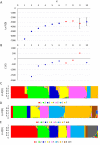Population, genetic, and antigenic diversity of the apicomplexan Eimeria tenella and their relevance to vaccine development
- PMID: 26354122
- PMCID: PMC4586875
- DOI: 10.1073/pnas.1506468112
Population, genetic, and antigenic diversity of the apicomplexan Eimeria tenella and their relevance to vaccine development
Abstract
The phylum Apicomplexa includes serious pathogens of humans and animals. Understanding the distribution and population structure of these protozoan parasites is of fundamental importance to explain disease epidemiology and develop sustainable controls. Predicting the likely efficacy and longevity of subunit vaccines in field populations relies on knowledge of relevant preexisting antigenic diversity, population structure, the likelihood of coinfection by genetically distinct strains, and the efficiency of cross-fertilization. All four of these factors have been investigated for Plasmodium species parasites, revealing both clonal and panmictic population structures with exceptional polymorphism associated with immunoprotective antigens such as apical membrane antigen 1 (AMA1). For the coccidian Toxoplasma gondii only genomic diversity and population structure have been defined in depth so far; for the closely related Eimeria species, all four variables are currently unknown. Using Eimeria tenella, a major cause of the enteric disease coccidiosis, which exerts a profound effect on chicken productivity and welfare, we determined population structure, genotype distribution, and likelihood of cross-fertilization during coinfection and also investigated the extent of naturally occurring antigenic diversity for the E. tenella AMA1 homolog. Using genome-wide Sequenom SNP-based haplotyping, targeted sequencing, and single-cell genotyping, we show that in this coccidian the functionality of EtAMA1 appears to outweigh immune evasion. This result is in direct contrast to the situation in Plasmodium and most likely is underpinned by the biology of the direct and acute coccidian life cycle in the definitive host.
Keywords: Eimeria; chickens; coccidiosis; food security; population structure.
Conflict of interest statement
The authors declare no conflict of interest.
Figures





References
Publication types
MeSH terms
Substances
Associated data
- Actions
- Actions
- Actions
- Actions
- Actions
- Actions
- Actions
- Actions
- Actions
- Actions
- Actions
- Actions
- Actions
- Actions
- Actions
- Actions
- Actions
- Actions
- Actions
- Actions
- Actions
- Actions
- Actions
- Actions
- Actions
- Actions
- Actions
- Actions
- Actions
- Actions
- Actions
- Actions
- Actions
- Actions
- Actions
- Actions
- Actions
- Actions
- Actions
- Actions
- Actions
- Actions
- Actions
- Actions
- Actions
- Actions
- Actions
- Actions
- Actions
- Actions
- Actions
- Actions
- Actions
- Actions
- Actions
- Actions
- Actions
- Actions
- Actions
- Actions
- Actions
- Actions
- Actions
- Actions
Grants and funding
LinkOut - more resources
Full Text Sources
Other Literature Sources

